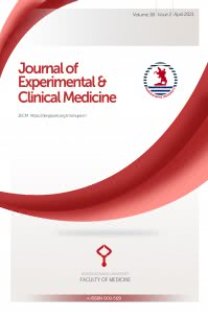Gaziantep il merkezindeki gebe kadınlarda A vitamin ve B-karoten düzeyleri
Gebelik, Vitamin A, Beta karoten, Fotometre, Araştırma teknikleri
Plasma vitamin A and B-caroten levels in pregnant women living in Gaziantep
Pregnancy, Vitamin A, beta Carotene, Photometry, Investigative Techniques,
___
1. Chanıpe PC, Harvey RÂ. Biyokimya (2. Baskı). Çevirenler: Tokullugil, Dirican M, Ulu kaya E. İstanbul, Nobel Tıp Kitabevleri, 1997: 319-342. 2. Cayvela MM. Oxygen Free Radicals and Human Diseas. Biochemie 1995; 77: 147-161. 3. Delattre J, Rousselot DB. Oxidative Stress Free Radicals and Aging. Biotech lab. International 1998; March-april: 21-23. 4. Brewster MA. Vitamins. In: Clinical Chemistry (3 rd ed). Kaplan LA, Pesce AJ (ed). USA, Mosby-year book, 1996; 760-793. 5. Me Cormick DB, Green HL. Vitamins. In: Tietz Textbook of Clinical Chemistry (3 rd ed). Burtis CA, Ashwood ER (ed). Chapter 29, Philadelphia, WB Saunders Company, 1999: 999-1029. 6. Yavuzer S. Serbest Oksijen Radikallerine Karşı Savunma Sistemleri (Antiioksidan Savunma). TTB Tıpta Temel Bilimler Kolu Sonbahar Okulu. Kızılcahamam, 1993:7-17. 7. Açkurt F, Löker M, Welherilt H. Pre ve Postnatal Dönemdeki Annelerin Besin Düzeylerinin Değerlen¬ dirilmesi. Beslenme ve Diyet Dergisi, Nutr and Diet 1996; 25: 5-15. 8. Yevm KJ, Ferland G, Patıy J, et al. Relationship of plasma carotenoids retinol and tocopherols in mothers and newborn infants. J Am Coll Nutr 1998: 17: 442-447. 9. Torfs CP, Lam PK, Schaffer DM, et al. Association between mothers nutrient intake and their offspring's risk of gastroschisis. Teratology 1998: 58: 241-250. 10. Zhang C. Williams MA, Sanchez SE, et al. Plasma concentrations of carotenoids, retinol, and tocopherols in preeclamptic and normotensive pregnant women. AmJ Epidemiol 2001; 15: 153: 572-580. 11. Kayaalp SO. Tıbbi Farmakoloji, Vitaminler, Cilt 2, bölüm 11. 8. baskı. Ankara. Hacettepe Taş Kitapçılık, 1998; 1529-1563. 12. Sümbüloğlu K, Sümbüloğlu V. Bioistatistik Kitabı. 3. baskı. Ankara, Hatiboğlu Yayınevi, 1990;60-80. 13. Parazzini F, Vecchia CL, Mangili G, et al. Dietaıy factors and risk of trophoblastic disease. Am J Obstet Gynecol. 1988; 158: 93-100. 14. Daniel LR, Chew BP, Tanaha TS, et al. ş-carotene and vitamin A effects on bovine phagocyte function invitro during the perpartum period. J Dairy Sci 1991; 74: 124-131. 15. Gülmezoğlu AM, Hofmeyr GJ, Osthuisen MMJ. AnLioxidant in the treatment of severe preeklampsia an explanatory randomised controlled trial. Br J Obstet Gynaecol 1997; 104: 689-696. 16. Friedrich W. Vitamin and its Provitamins. In: Gruster W (ed) Vitamins. Newyork, Mosby, 1988; 64-139. 17. Christian P, Schulze K, Stoltzfus RJ, et al. Hyporetinolemia, illness symtoms and acuta phase protein respanse in pregnant women with and without night blindness. Am J Clin Nutr 1998; 67: 1237-1243. 18. Trugo NM. Micronutrient regulation in pregnant and lactating women from Rio de Jeneiro. Arch Lanoam Nutr 1997:47: 30-34.19. Ocampo MB, Moriya K. A comparative study of nutrition and health of mothers in Japan and the Philippines. Southeast Asian J Trop Med Public Healh 1997; 28: 645-656. 20. Goadel JC, Mosv TK, Pabst HF. Perinatal vitamin A (retinal) status of northern Canadian mothers and their infants. Biol Neonate 1996; 69: 133-139. 21. Ortega KM, Andres P, Martinaz RM. Vitamin A status during the third trimester of pregnancy in Spanish women: Influence on concentrations of vitamin A in breast milk. Am J Clin Nutr 1997; 66: 564-568. 22. Antal M, Regöly MA, Varsany H, et al. Nutritional survey of pregnant women in hungary. Int J Vitam Nutr Res 1997; 67: 115-122. 23. Tamura T, Goldenberg RL, Johston KE et al. Serum concentrations of zinc, folate, vitamin A and E and proteins and their relationships to pregnancy outcane. Acta Obstet Gynecol Scand Suppl 1997; 165: 63-70. 24. Jendryczko A, Drozdz M. Plasma retinal, b-karotene and vitamin E levels in relation to the future risk of preeclampsia. Zentralbl Gynacol 1989; 111: 1121-1123. 25. Chaxla PK, Pan R. Impact of nutrional supplements on hematological Profile of pregnant women. Indian Pediatr 1995; 32: 976-980. 26. Villard L, Bates CJ. Caroten dioxygenace (EC 1.33.11.21.) Activity in rat intestine: Effects' of vitamin A deficiency a of pregnancy. Br J Nutr 1986; 56: 115-122.
- ISSN: 1300-2996
- Yayın Aralığı: Yılda 4 Sayı
- Başlangıç: 2018
Motor eşgüdümde dopaminerjik sistemin rolü
Mehmet KURT, Süleyman ÇELİK, Yüksel KESİM
Şizofrenide risperidon ile olanzapinin karşılaştırılması
Gaziantep il merkezindeki gebe kadınlarda A vitamin ve B-karoten düzeyleri
Şahin KILINÇER, İclal MERAM, Ali İhsan BOZKURT
Multipl sklerozda human lökosit antijen sıklığının incelenmesi
Hüseyin ATEŞ, Gülten TUNALI, Belma DURUPINAR
The acanthosis nigricans associated with gastric adenocarcinoma and neurofibromatosis
Tayyar CANTÜRK, Levent YILDIZ, Asiye YILDIZ, Oğuz AYDIN, Ahmet Yaşar TURANLI
Zahide DOĞANAY, Fikret BİLDİK, Dursun AYGÜN, Hakan GÜVEN, Levent ALTINTOP, Murat YERLİYURT
Çocukluk çağı kanser hastalarının epidemiyolojik incelenmesi
Nilgün ÖZBEK, Şaban ÇAKIR, Baki TARAKÇI, Melek COŞKUN
Sayit ALTIKAT, Mehmet Emin BÜYÜKOKUROĞLU, Mehemt ÇİFTÇİ, Nuri BAKAN, ÖMER İRFAN KÜFREVİOĞLU
